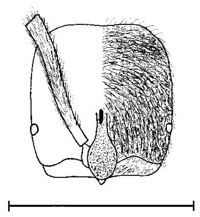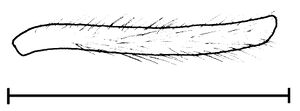Simopelta breviscapa
| Simopelta breviscapa | |
|---|---|

| |
| Scientific classification | |
| Kingdom: | Animalia |
| Phylum: | Arthropoda |
| Class: | Insecta |
| Order: | Hymenoptera |
| Family: | Formicidae |
| Subfamily: | Ponerinae |
| Tribe: | Ponerini |
| Genus: | Simopelta |
| Species: | S. breviscapa |
| Binomial name | |
| Simopelta breviscapa Mackay, W.P. & Mackay, E.E., 2008 | |
Most specimens of this species, all workers, were extracted from leaf litter.
Identification
Mackay and Mackay (2008) - This small species could be confused with Simopelta williamsi and Simopelta fernandezi. It can be easily distinguished by the short antennal scapes. The transverse striae on the posterior half of the head are not as well defined as they are in S. fernandezi, and especially in S. williamsi. It could also be confused with Simopelta longirostris, from which it differs in having a less developed lobe on the clypeus. It could also be confused with S. longinoda, the other species in which the antennal scape barely exceeds the posterior lateral corner of the head. It differs in having a wider petiolar node (length 0.23 mm, maximum width 0.25 mm; versus length 0.23 mm, maximum width 0.20 mm in S. longinoda). Additionally, the lower parts of the pronotum and mesopleuron are sculptured and only moderately shining, not smooth and glossy as in S. longinoda.
Keys including this Species
Distribution
Chiriqui, Panama.
Distribution based on Regional Taxon Lists
Neotropical Region: Panama (type locality).
Distribution based on AntMaps
Distribution based on AntWeb specimens
Check data from AntWeb
Countries Occupied
| Number of countries occupied by this species based on AntWiki Regional Taxon Lists. In general, fewer countries occupied indicates a narrower range, while more countries indicates a more widespread species. |

|
Estimated Abundance
| Relative abundance based on number of AntMaps records per species (this species within the purple bar). Fewer records (to the left) indicates a less abundant/encountered species while more records (to the right) indicates more abundant/encountered species. |

|
Habitat
Upper montane cloud forest, at 700 - 1520 m elevation.
Biology
Castes
Known only from the worker caste.
Worker

| |
| . | |
Nomenclature
The following information is derived from Barry Bolton's Online Catalogue of the Ants of the World.
- breviscapa. Simopelta breviscapa Mackay & Mackay, 2008: 298, figs. 6, 12, 13, 16, 30 (w.) PANAMA.
- Type-material: holotype worker, 4 paratype workers.
- Type-locality: holotype Panama: Chiriqui, Fortuna Area, Finca La Suisse, 11.vi.1995, #17826 (R. Anderson); paratypes with same data.
- Type-depositories: MCZC (holotype); CASC, GFMP, IAVH, WEMC (paratypes).
- Distribution: Panama.
Unless otherwise noted the text for the remainder of this section is reported from the publication that includes the original description.
Description
Worker
This is a relatively small species (total length about 3.5 mm), black, with brown mandibles, antennae, and legs, which are pale brown at the extremities. The mandible has three teeth, the basalmost tooth is often obliquely truncated and dull. The head length ranges from 0.89-0.90 mm, the head width ranges from 0.74-0.76 mm. The eye is small (maximum diameter 0.06-0.07 mm). The antennal scape (0.79-0.83 mm) barely surpasses the posterior lateral margin of the head. The mesonotum is broadly convex, and shorter in length than the dorsal face of the propodeum. The anterior and posterior faces of the petiole are nearly parallel, forming a well-developed, horizontal apex, which has a broadly convex surface. The spiracular horns are well developed, and the subpetiolar process is triangular-shaped, with a slightly concave posterior face.
Short (0.03 mm), erect and suberect hairs are present on most surfaces, including the dorsal and ventral surfaces in the head, dorsum of the mesosoma, and dorsum of the petiole. Longer erect hairs are sparse, and mostly restricted to the mandibles, ventral surface of the head, and the gaster.
The mandibles are finely striated, the dorsum of the head is covered with granulated sculpture, forming poorly defined, transverse rugulae (at least near the posterior edge), which become longitudinal on the sides and anterior half of the head. The pronotum is granulated, with poorly defined, transverse rugulae. The posterior part of the side of the pronotum is smooth and glossy, the remainder of the pronotum has longitudinal rugulae. The mesonotum and dorsum of the propodeum have poorly defined, transverse striolae; the striae on the sides of the mesosoma are mostly longitudinal. The sides of the petiolar node have striolae, which encircle the node, the apex of the node has transverse rugulae. The gaster is smooth and glossy.
Type Material
Holotype worker (Museum of Comparative Zoology), 4 paratype workers (California Academy of Sciences, William and Emma Mackay Collection, Graham B. Fairchild Museo de Invertebrados, Humboldt Institute), Panamá, Chiriquí, Fortuna Area, Finca La Suisse, 11-vi-95, R. Anderson # 17826.
Etymology
From Latin, brevis meaning short, and scapus, meaning staff, referring to the relatively short antennal scape.
References
References based on Global Ant Biodiversity Informatics
- Mackay W. P., and E. E. Mackay. 2008. Revision of the ants of the genus Simopelta Mann. Pp. 285-328 in: Jiménez, E.; Fernández, F.; Arias, T.M.; Lozano-Zambrano, F. H. (eds.) 2008. Sistemática, biogeografía y conservación de las hormigas cazadoras de Colombia. Bogotá: Instituto de Investigación de Recursos Biológicos Alexander von Humboldt, xiv + 609 pp.
